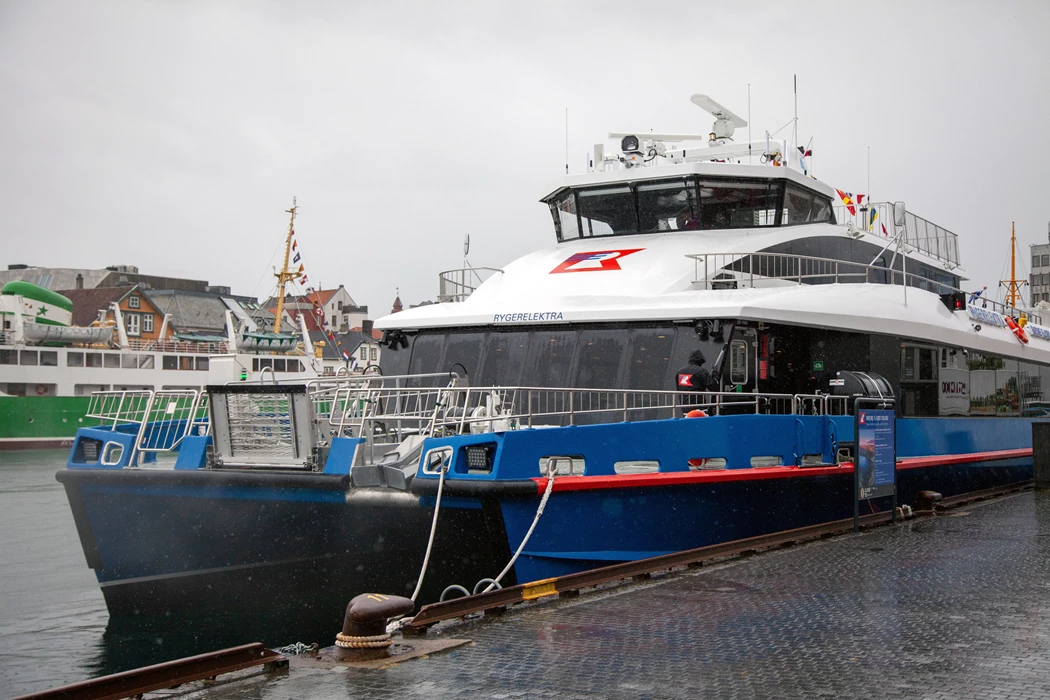Travel Norway’s Fjords on a Quiet Electric Ferry
The Scandinavian nation, already a leader in electric cars, has in recent years been churning out zero-emissions vessels that could one day be used all over the world. Right now the ships mostly ply key domestic routes, especially in the mountainous west coast where ferries are an essential piece of the transportation network.
But they’ve already made Norway the most electrified shipping nation in the world, thanks to an aggressive government push to cut maritime emissions. The country is home to almost three-quarters of the 274 vessels globally that run at least partly on batteries, according to a state advisory body. Its fleet of 31 fully-electric car ferries is expected to nearly double by the end of the year, says the Green Shipping Programme, a public-private partnership that supports the transition. Even the sightseeing ferries that cruise Norway’s famous fjords are transitioning to battery power.

On a Saturday morning in Stavanger, along Norway’s west coast, a new ferry, the Rygerelektra, is in the harbor preparing for a tour of some nearby fjords. Measuring 42 meters long with seating capacity of nearly 300, the ferry, is owned and operated by Rødne Fjord Cruises. It is among a group of vessels from several of Norway’s leading maritime companies that are driving a shift towards zero-emissions fleet and supporting Norway’s ambitious economic reinvention away from oil and gas to alternative energy source.
"We have this closeness to the ocean in Norway, and the pinnacle of Norwegian business somehow has always sprung out of that,” says Silje Bareksten, chief sustainability officer at 3 Norske AS and a former official at Nor-shipping, a biannual maritime trade fair held in Oslo. Today, Bareksten says, the "need to find new, ecologically and financially sustainable ways of doing business in the years to come” is gaining wider acceptance among among public and private entities, and helping to build momentum in the right direction.
When the Rygerelektra debuted last summer, a state broadcaster in Norway described it as the fastest and longest-range electric ferry in the world, a difficult feat for machinery that is battery-powered. Just as with electric automobiles, range anxiety, or , is a real fear, acknowledges Lars Rødne, the cruise operator’s chief executive officer. “You have to make sure you can come back!”
A large liquid crystal display on the bridge highlights the vessel's battery status at all times. The Rygerelektra typically starts with 85% charge. After a three-hour, 40 nautical mile round trip through the fjords – it runs at around 15 knots, but, the company says, can handle 23 knots in speed tests — the ferry winds up back in Stavanger with about 15% battery power remaining.
Rygerelektra was built by Brødrene Aa, a small family shipbuilding firm tucked inside a fjord a few hundred miles to the north of Stavanger. The company made a name for itself in the early 2000s as a pioneer in the use of carbon fiber fast ferries, vessels that largely cover trunk routes between cities along Norway’s west coast. They have over 60 such vessels today, covering deliveries in Norway and to Asia — workhorses that move quickly, and weigh far less than counterparts made from traditional metals.
Over the last few years, Brødrene has branched out into all-electric vessels, delivering its first, a sightseeing ferry named Future of the Fjords, in 2018. It took the company just two years to make the leap to a fully battery-powered ship after producing a predecessor ship, Vision of the Fjords, that uses a hybrid engine.
Higher efficiency carbon fiber vessels have allowed the firm to begin exploring battery-powered alternatives. “We’re going through different phases, like in the car industry,” says Lars Gimmestad, the deputy CEO at Brødrene. “The first phase was lowering emissions on traditional fuels. In one test we did, the carbon fiber reduced the fuel costs 40%. And then we stepped into the next phases.”

an entire room, like some kind of science fiction walk-in closet, is filled with batteries hidden behind white metal doors marked with high voltage warnings. Inside a series of fans whirred along at high speed to keep everything cool, drowning out most other sound. All to power a motor not much bigger than a large suitcase.
Government restrictions are also accelerating the shift. Diesel ships will be banned from all of Norway’s UNESCO-designated fjords starting in 2026. Some operators have already made the switch. The Lysefjord, where Rygerelektra operates, doesnt currently fall under that ban, but Lars Rødne thinks its going to extend everywhere eventually, beyond UNESCO sites.

Still, solutions are emerging.

More stories like this are available on bloomberg.com
©2021 Bloomberg L.P.





